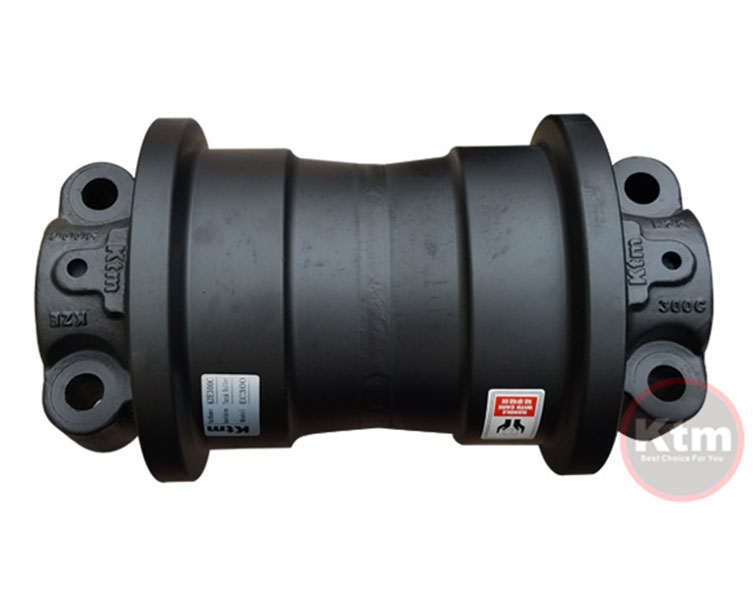
- Home
- Product
- Solution
- Brand Products
- About
- News
- Contact Us
- Language

Call Anytime
18929567376
Supporting wheels and idler wheels are key components in the "four-wheel belt" of tracked construction machinery chassis, and they have significant differences in structure, function, and usage scenarios. Here is a detailed comparison between the two: 1. Structure and composition. Supporting wheels: Supporting wheels are usually composed of main shafts, wheel bodies, shaft sleeves, outer covers, inner covers, and other components. The wheel body is generally larger and used to support the weight of heavy machinery.
Supporting wheel: The structure of supporting wheel is relatively simple, usually including components such as wheel body, bearings, and mounting seat. The size of the supporting wheel is generally small, mainly used to support the track and prevent it from sagging too much.

2、 Function and function of supporting wheels
Supporting wheels: The main function of supporting wheels is to support the weight of heavy machinery, allowing the machinery to travel smoothly on the tracks. It can also limit the tracks, prevent them from slipping laterally, and ensure the stability and safety of the machinery during operation.
Supporting wheel: The main function of the supporting wheel is to support the track, prevent the track from sagging too much, and thus reduce the vibration and jumping phenomenon of the track during movement. It can also prevent the track from slipping laterally, ensuring that the track can tightly fit between the drive wheel and the guide wheel.
3、 Usage scenarios
Supporting wheels: Supporting wheels are widely used in heavy machinery such as excavators and bulldozers to support the weight of the machinery and guide the tracks forward.
Supporting wheels: Supporting wheels are usually installed at the bottom of tracked construction machinery, and are used in conjunction with support wheels, drive wheels, and guide wheels to ensure the smooth operation and safety of the machinery.
4、 Performance characteristics
Supporting wheels: Supporting wheels need to have high strength, high wear resistance, and good sealing performance to adapt to harsh working environments and withstand strong impacts.
Supporting wheels: Although supporting wheels bear relatively small loads, they still need to have good wear resistance and sealing performance to ensure their long-term stable operation. In summary, there are significant differences between supporting wheels and supporting wheels in terms of structure, function, usage scenarios, and performance characteristics. In tracked construction machinery, they each play an irreplaceable role in ensuring the smooth operation and safety of the machinery.
There is indeed a difference in size between the supporting wheel and the supporting wheel, mainly reflected in their diameter, width, and center hole diameter. The following is a detailed comparison of the size of the two: 1. Diameter supporting wheel: The diameter range of supporting wheels is relatively large, usually between 100mm and 1200mm. Common specifications include 250mm, 300mm, 350mm, 400mm, 450mm, 500mm, 550mm, 600mm, 650mm, 700mm, 800mm, etc. The choice of diameter usually depends on the weight of the heavy machinery, the operating environment, and the required load-bearing capacity.
Supporting wheel: The diameter of the supporting wheel is relatively small, usually much smaller than the diameter of the supporting wheel. The specific diameter size may vary depending on different models of tracked construction machinery.
2、 Width
Supporting wheels: The width range of supporting wheels is also relatively large, generally between 50mm and 300mm. Common specifications include 50mm, 75mm, 100mm, 125mm, 150mm, 175mm, 200mm, 250mm, etc. The choice of width is usually related to the diameter of the support wheel, the size of the heavy machinery, and the operational requirements.
Roller support: The width of the roller support is generally small to meet its functional requirements for supporting the track. The specific width size may vary depending on the design of the idler and the model of the tracked construction machinery.
3、 Center hole diameter
Supporting wheel: The diameter of the center hole of the supporting wheel is an important parameter for installing the main shaft. Common specifications include 25mm, 30mm, 50mm, 70mm, etc. The selection of the center hole diameter should match the diameter of the main shaft to ensure that the supporting wheel can be stably installed on the chassis.
Supporting wheel: The diameter of the center hole of the supporting wheel should also match the diameter of the mounting seat or bearing. The specific diameter of the central hole may vary depending on the design and installation requirements of the supporting wheel. In summary, there are significant differences between the supporting wheel and the supporting wheel in terms of diameter, width, and center hole diameter. These differences enable them to adapt to different working environments and functional requirements, jointly ensuring the stability and safety of tracked construction machinery. When selecting and using, comprehensive consideration should be given to the specific mechanical model, operational requirements, and environmental conditions.













